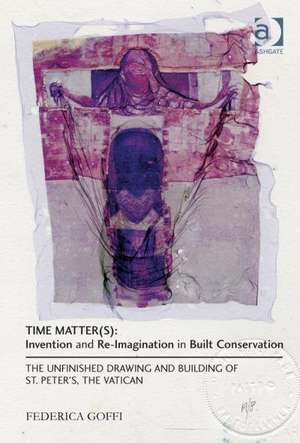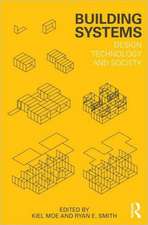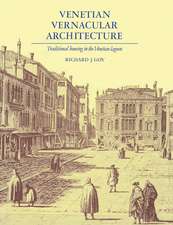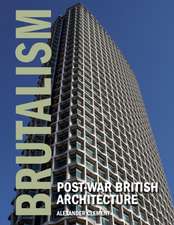Time Matter(s): Invention and Re-Imagination in Built Conservation: The Unfinished Drawing and Building of St. Peter's, the Vatican
Autor Federica Goffien Limba Engleză Hardback – 13 sep 2013
| Toate formatele și edițiile | Preț | Express |
|---|---|---|
| Paperback (1) | 489.10 lei 6-8 săpt. | |
| Taylor & Francis – 17 noi 2016 | 489.10 lei 6-8 săpt. | |
| Hardback (1) | 1120.23 lei 6-8 săpt. | |
| Taylor & Francis – 13 sep 2013 | 1120.23 lei 6-8 săpt. |
Preț: 1120.23 lei
Preț vechi: 1366.14 lei
-18% Nou
Puncte Express: 1680
Preț estimativ în valută:
214.35€ • 223.82$ • 177.01£
214.35€ • 223.82$ • 177.01£
Carte tipărită la comandă
Livrare economică 15-29 aprilie
Preluare comenzi: 021 569.72.76
Specificații
ISBN-13: 9781409443018
ISBN-10: 1409443019
Pagini: 280
Dimensiuni: 174 x 246 x 18 mm
Greutate: 0.77 kg
Ediția:New.
Editura: Taylor & Francis
Colecția Routledge
Locul publicării:Oxford, United Kingdom
ISBN-10: 1409443019
Pagini: 280
Dimensiuni: 174 x 246 x 18 mm
Greutate: 0.77 kg
Ediția:New.
Editura: Taylor & Francis
Colecția Routledge
Locul publicării:Oxford, United Kingdom
Cuprins
Contents: Preface; Prologue: notes on the ontology of remaking mnemic buildings; Introduction to a micro-historical study of the renovation of St Peter’s basilica in the Vatican, (1506-1626); Architecture’s twinned body: building and drawing; ’Hallowed configuration’: the mediating role of architectural representation in built conservation; Stratigraphic drawings and the drawings of members: assembling the exquisite corpse; Restoring the corporate body: heteroglossia versus unity of style; Framing the icon. Skin-deep conservation versus the imagination of built conservation; Time matter(s). The sempiternal nature of built conservation; The role of ambiguity and the unfinished in defining built conservation; Bibliography; Index.
Notă biografică
Dr Federica Goffi, Azrieli School of Architecture & Urbanism, Carleton University, Canada.
Recenzii
’Time Matter(s) is a unique and timely scholarly study of Tiberio Alfarano’s mysterious drawing of St Peter’s Basilica from the late 16th century, examining the work in the context of the temporality of building conveyed through the symbolic inter-relationships between the old and new basilicas. The drawing is unique in simultaneously depicting the building as both a ’receptacle’ of memory (in regard to the historical developments and adaptations of the original Constantinian basilica) and as an anticipatory expression of the completed new basilica, which at the time was still under construction. Understood more as a sacred artifact than a mere drawn depiction, the representation reveals much about the relationship between conserving the past and creating a new architectural order, which the author examines with great acumen and scholarly insight. At the same time, the author argues that the artifact provides a rich and fertile source of ideas about broader issues of building conservation today, providing a critical point of reference for re-evaluating the nature and meaning of historical and cultural continuity as a problem of architectural representation. The book would be of interest to both practitioners and academics, challenging conventional assumptions of an unmediated relationship between history and creativity that has become endemic in architectural conservation today.’ Nicholas Temple, University of Huddersfield, UK ’This book is a ground-breaking event in the field and deals with materials that for some strange and unclear reasons have been completely overlooked in both the history of St. Peter’s and within theories of historic conservation. The backbone of the book, the analysis of the Tiberio Alfarano’s artifact is very exhaustive and far-reaching in singling out the cultural interaction between representations and buildings. The evaluation of Alfarano’s unique facture is done with very sophisticated sensorial procedures and it wi
Descriere
This book fills in a blind spot in current architectural theory and practice, looking into a notion of conservation as a form of invention and imagination, offering the reader a counter-viewpoint to a predominant western understanding that preservation should be a 'still shot' from the past. Through a micro-historical study of a Renaissance concept of restoration, this book provides a theoretical framework to question the issue of conservation as a possible creative endeavour, when a mnemonic building is concerned, entailing conservation of memory within changes. It focuses on Tiberio Alfarano's 1571 ichnography of St. Peter's Basilica in the Vatican, into which was woven a complex body of religious, political, architectural and cultural elements.






